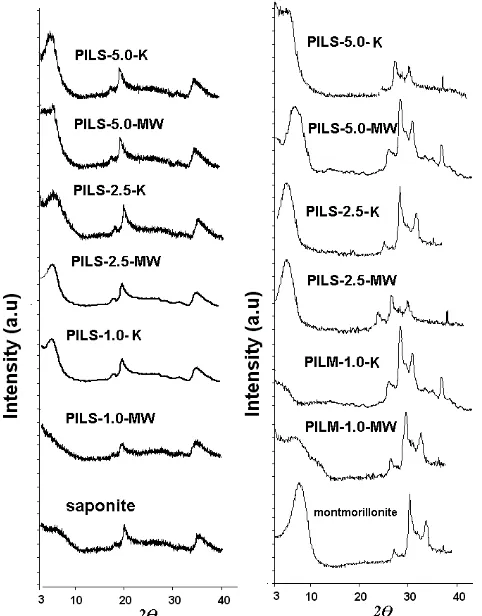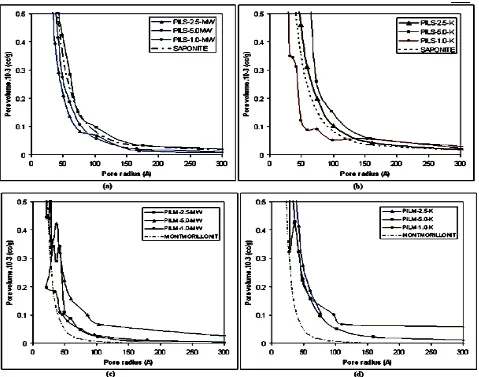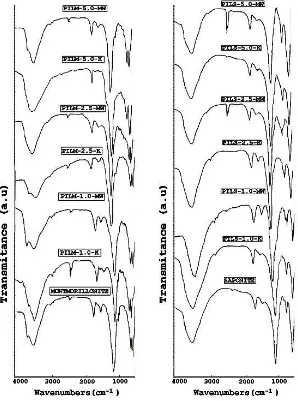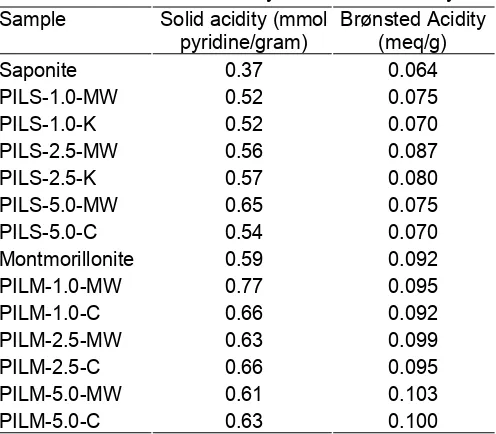* Corresponding author. Tel/Fax.: +62-274-896439/895920
CONTROLLING FACTOR IN ALUMINA PILLARED SAPONITE AND ALUMINA PILLARED
MONTMORILLONITE SYNTHESIS
Is Fatimah
1*, Narsito
2, and Karna Wijaya
2 1Chemistry Dept., Islamic University of Indonesia, Kampus Terpadu UII, Jl. Kaliurang Km.14, Besi, Yogyakarta 55581 2
Chemistry Dept., Gadjah Mada University, Sekip Utara Bls 21, Yogyakarta
Received May 5, 2008; Accepted March 3, 2009
ABSTRACT
The effect of synthesis parameters to the physical properties of pillared saponite and pillared montmorillonite was examined. Mol ratio of Al to clay mass in the range 1.0 - 5.0 and two different calcination methods; conventional calcination and microwave irradiation method are evaluated as controlling factors to evolution of basal spacing d001 , surface acidity, specific surface area, pore distribution and catalytic activity in phenol hydroxylation reaction. XRD, FTIR, and N2-adsorption/desorption analysis were used to characterize the materials. Results showed that pillarization produced higher basal spacing d001 and surface acidity and crystalinity of materials in all Al/clay ratio and in both of the calcination methods. In general, Al to clay mass ratio and calcination method remarkably influence to the basal spacing d001, surface acidity and material crystallinity, but the effect of these factors to catalyst activity in phenol hydroxylation depends on nature of clay. It is concluded that the activity as catalyst is affected by the presence of ionic species and surface acidity in the minerals.
Keywords: Pillared smectite, surface acidity, calcination INTRODUCTION
Smectite classes of clay are characterized by octahedral alumina and tetrahedral silicate in the ratio of 2:1. The substitution of Al3+ in the octahedral sheet by Mg2+, resulted in a negative layer charge that is compensated by hydrated cations adsorbed in the interlamellar space. These cations can easily be substituted by others presenting in solution. Other specific properties in application as heterogeneous catalyst are the lack of thermal stability due to its structure. On the basis of exchangeable cations, intercalation process by larger polyoxocation and followed by calcination to form stable metal oxide could be performed. This process exhibits larger specific surface area, solid acidity and also thermal stability. The distribution of pore size and also acidity is determined by species of polyhydroxy cation used. Among several kinds of metal such as, Ti, Zr, Zn, Cr and other transition metals, alumina is the most frequently used as pillaring
After pillarization, calcination step performed to convert this polyhydroxy form to metal oxide with this equation: [Al13O4(OH)24(H2O)12] physicochemical character of pillared smectite. Several authors have extensively studied the preparation techniques for aluminum-pillared clays. In addition, Several parameters in the synthesis consisting of
converting homoionic forms of parent smectite, method for Al13 preparation enganged, high concentration of
clays suspension and also microwave irradiation method as alternative procedure for calcination are studied [1-3]. Meanwhile, the last method; the microwave irradiation procedure was interesting method to have time effective synthesis. In the conventional calcination, dehydroxylation step is conducted by heating intercalated clays in low heating rate (1-5 K/min), so the process needs long time to do. Microwave irradiation is based on the highly energy of irradiation in faster time for the synthesis of alumina and titania pillared montmorilonite[4,5].
The discussion from this method concerned on dealumination effect reduced by this method. Shorter period of steaming should limit the extraction of the pillar phases like anatase and alumina from the clay framework, with respect to the solids prepared by the conventional methods. In turn, less than amounts of alumina and anatase impurities should decrease the blockage of pores in the catalyst supports, which in turn should enhance the diffusion of gas phase molecules. Surface acid sites of the microwave irradiated solids were primarily in the range of medium to strong Lewis type sites.
EXPERIMENTAL SECTION
Material
The starting material was synthetic saponite (Sumecton SA), supplied by Kunimine Co and used as received. Natural montmorillonite was supplied by PT.Tunas Inti Makmur, Semarang.
Instruments
Analytical instrument used for catalyst characterization were X-ray Diffraction (XRD) Shimadzu X6000, Gas Sorption Analyzer NOVA 1000, FTIR Nicolet Avatar and Spectrophotometer Uv-Visible HITACHI U-2080. High Performance Liquid Chromatography (HPLC) Shimadzu was used for analysis of composition in the product of catalyst activity test.
Procedure
Synthesis of Al2O3-Pillared Smectite
Clay samples were dispersed in water in the concentration of 2% (w/v) and aged for a night before intercalated with Al13 polyoxocation. Alumina
polyoxocation Al13 was prepared by the slow addition of
NaOH to AlCl3 solution under vigorous stirring, so that
the -OH/Al mole ratio was equal to 2.2 [6,7]. This solution was used for intercalation without prior aging. The Al13
solution was added to the clay suspension (pH = 4.1) at varied ratio of 1.0, 2.5 and 5.0 mmol Al/g of clay. The solution was kept at room temperature for 24 h, washed and neutralized until Cl- was free and conductance of filtrate less than 1 S, and then dried in oven at 130 °C. Calcination step by microwave irradiation performed for 10 minute at 150 W with frequency of 2.45 MHz. For comparison purpose, conventional calcination was done at 500 °C for 4 h, with a heating rate from room temperature to the calcination temperature of 1 K/min. The Solids produced are designated by the following nomenclature: 1.0 , 2.5 and 5.0 indicated mmol Al/g of clay used in intercalation, MW indicates microwave irradiation method used for calcination respectively.
Material Characterization
The solids were characterized by X-ray diffraction using a XRD X 6000 Shimadzu diffractometer filtered using Cu K radiation and Ni filter. Surface area analyzer NOVA 1000 instrument was used for surface area, pore distribution and pore volume measurement. While, Surface acidity was determined via FTIR of adsorbed pyridine, using a FTIR Nicolet Avatar spectrophotometer. Samples in the glass chamber were evacuated at the pressure of 0.3 atm for 3 hours before were exposed by pyridine vapor for 24 hours. Samples were degassed at room temperature for 3 hours before
weighing and their spectra were recorded by FTIR spectrophotometer. BrØnsted acidity of materials were analyzed by n–butylammine titration method as the method reported by Ruiz et al. (2004) [8]. One hundred miligram of sample was was dilluted in deionized water and homogenized by sonification for 15 mins. To the acid sites. Furthermore, the elemental analysis of SiO2
and Al2O3 in both clays was performed by gravimetric
method, and other elements: Na, Ca and Mg which were analyzed by Atomic Absorbtion Spectrophotometry.
Cation exchange capacity (CEC) was used for predicting ionic formation before and after pillarization determined via methylene blue adsorption as reported in literature [6,7,9]. Exchanged methylene blue was measured by UV-Visible spectrophotometry. Finally, the catalytic activity of pillared saponites was evaluated in phenol hydroxylation reaction. The choice of phenol hydroxylation reaction as the model reaction for the characterization of the acidity of solids was based on the reactions of alkenes with acid solids reported in the literature [10-13] The synthesis parameters give effect to the porous structure, as well as the acid/basic nature of the solids which will influence the activity in catalytic reaction.
Catalytic Activity Test
Reaction was carried out in three neck flask. One-half g of catalyst, 10 g of phenol and 10 g of methanol were introduced in a 100 mL equipped with a magnetic stirrer at 70 °C. Solution of H2O2 (30%) was added to
the reactor to a ratio of 0.2 H2O2/phenol. The liquid
samples were regularly withdrawn with a microfilter syringe 0.45 RC and analyzed by High Performance Liquid Chromatography Shimadzu with CBP5 packing column and acetonitrile-water in the ratio if 1:1 as eluent. The activity was defined as the mole fraction of the reacted phenol, which was converted into a given product [11,12].
RESULTS AND DISCUSSION
Physicochemical and mineralogical characteristic of saponite and montmorillonite were previously investigated. Chemical composition and also cation exchange capacity (CEC) of saponite and montmorillonite are presented in Table 1. A high content of MgO and low content of Al2O3 in saponite
Table 1. Chemical composition of raw saponite and raw
Table 2. Physicochemical character of materials
Sample d001
exchangeable. Cation exchange capacity of this material was 99 meq/100 g. Mineral data of montmorillonite indicate that SiO2 and Al2O3 are major content. Thus,
sodium, magnesium and calcium are exchangeable cations.
The XRD patterns of alumina pillared saponite(Al-PILS) and alumina pillared montmorillonite (Al-PILM) at different calcination method are shown in Figure 1 and basal spacing d001 values, specific surface area and pore
radius of samples are summarized in Table 2.
In general, pillarization produced higher basal spacing d001 of saponite structure and it indicated
alumina oxide formation in pillarization. Compared to raw saponite, it is concluded that higher alumina ion to clay mass ratio produce higher crystallinity shown by higher intensity of d001 reflection. Calcination method affecting
metal oxide formation can be observed by sharper reflection in all conventional calcined samples than those microwave irradiated samples. It is designated that crystallinity of conventional calcined samples microwave irradiated pillared saponite are higher. However, it is not linearly related to specific surface area character. It was observed that alumina pillared clays surface area were
Fig. 1 XRD pattern of pillared saponite (a) and pillared
montmorillonite (b) as effect of synthesis parameter developed via increasing Al/clay ratio. It was determined that conventional calcination method produced higher specific surface area than did microwave irradiated samples for the Al/clay ratio of 2.5 and 5.0. Beside, no considerable increase was observed in pillaring process with 1.0 Al/clay ratio. Pillared saponites reveal the effect of calcination method to the d001 values in which conventional
calcination method produce higher basal spacing than does microwave irradiation method for all Al/clay ratios.
This effect was also found in montmorillonite. Incomplete dehydroxylation process by the microwave irradiation was probably the main reason for this phenomenon. This assumption is related to the research reported by Andres et al. [10]. It is revealed that although higher basal spacing d001 was produced,
Al2O3 species in alumina pillared clays produced by
microwave irradiation were not stable to indicate incomplete process. Ordered structure in saponite as synthetic material make this effect clear. In contrast, higher basal spacings d001 were produced by
Fig. 2 Pore distribution of (a) pillared saponite produced by microwave irradiation (b) pillared saponite produced by conventional calcination (c) pillared montmorillonite produced by microwave irradiation and (d) pillared montmorillonite produced by conventional calcination
specific surface area in microwave irradiated samples in that it could be assumed that microwave irradiation probably causes dealumination process following dehydroxylation reaction needed. Many kinds of minerals in montmorillonite made some disorder for the process.
Although there is a relation between specific surface area and pore radius for all pillared samples, it was observed that the increase in specific surface area was not linearly correlated with the decrease in pore radius. As this character, there was not clearly relationship between basal spacing d001 value by Al/clay
ratio and kind of calcination methods. It is probably due to pore distribution for each sample.
Figure 2 reveals the effect of the differences between preparation variables to pore distribution profile. Calcination method effects pore distribution evolution in that microwave irradiation does not significantly influence the distribution compared to raw saponite and montmorillonite. Slight increase adsorption profile of
microwave- irradiated sample is shown by PILS-5.0-MW and PILM-5.0-PILS-5.0-MW. It is related to modal pore profile at about 50 Å which is probably the indication for house of cards formation [1]. This assumption seems related to the increase of specific surface area. Modal pore formation is also depicted by PILM-5.0-K and PILM-1.0-K but it was not shown in PILS-5.0-K. Modal pore formation in both PILM is the indication for dealumination process during pillarization and calcination as the effect of impurities in raw montmorillonite as assumed by XRD profiles (Fig.1). Surface acidity
FTIR spectra of materials after were treated by pyridine adsorption and evacuation process is presented in Figure 3.
Fig. 3 FTIR Spectra of (a) Montmorillonite and Alumina Pillared Montmorillonite (b) Saponites and Alumina Pillared Saponite after Pyridine Adsorption and Evacuation Process
pyridine interaction with clay surface. The band at 1630 cm-1 is detected for all samples. This band corresponded to slight intensity band at 1635cm-1. First band is attributed to pyridine adsorbed on Lewis acid sites, and the second at 1635 cm-1, related to pyridine adsorbed on Brønsted sites. The other bands localized at 1545-1555 cm-1 is assigned to pyridine adsorbed on Brønsted acid sites and the band at 1445-1455 cm-1 is attributed to pyridine adsorbed on Lewis acid sites as reported by Carvalho, et. al. and Ahenach, et.al [14,15]. Quantitative analysis data of solid acidity as pyridine adsorbed by samples and Brønsted acidity from the n-butylammine titration method are tabulated in Table 3.
As shown in Table 3, solid acidity is not influenced by Al/clay ratio and calcination method in synthesis. For both clays, it can be concluded that pillared form has higher acidity than raw clays. Dehydroxylation process in calcination step leds to produce acid (H+) as the
Brønsted Acid site. It could be assumed that Lewis acid and a wider pore formation by pillarization are the main reason for this phenomenon In fact, Lewis acid-base in pyridine adsorption is the main interaction occurred as the physical effect due to the molecule size of pyridine. Brønsted acidity data show the significant difference between alumina pillared saponite and montmorillonite. It can be assumed that this effect is in a linear correlation with cation exchange capacity data. Montmorillonite and pillared montmorillonite samples have higher Brønsted site than saponite and pillared saponite samples.
Catalytic Acitivity test
Fig. 4 . Histogram of material (a) saponite and pillared saponite (b) montmorillonite and pillared montmorillonite
catalytic activity in phenol hydroxylation
Table 3. Quantitative analysis of surface acidity
Sample Solid acidity (mmol pyridine/gram)
Brønsted Acidity (meq/g)
Saponite 0.37 0.064
PILS-1.0-MW 0.52 0.075
PILS-1.0-K 0.52 0.070
PILS-2.5-MW 0.56 0.087
PILS-2.5-K 0.57 0.080
PILS-5.0-MW 0.65 0.075
PILS-5.0-C 0.54 0.070
Montmorillonite 0.59 0.092
PILM-1.0-MW 0.77 0.095
PILM-1.0-C 0.66 0.092
PILM-2.5-MW 0.63 0.099
PILM-2.5-C 0.66 0.095
PILM-5.0-MW 0.61 0.103
PILM-5.0-C 0.63 0.100
the GC-MS analysis, hydroquinon were observed as the major products. This clearly suggests that the role of pillarization and increase in surface acidity to the activity. However, mmol Al to clay mass ratio does not significantly influence the activity. We speculate that this result may be due to the similar surface acidity among pillared form. The effects of calcination method, surface acidity, and specific surface area are not clear in pillared saponite. In contrast, The effect of synthesis parameter is clearer in pillared montmorillonite, in which microwave irradiated samples produce higher activity and lower mmol Al to clay mass ratio increase the activity. It was observed that surface acidity significantly was influence the activity. Higher activity of pillared montmorillonite was probably due to presence of higher distribution of
Brønsted acid site in samples that lay role in the mechanism. Protonation step is required in the initiation process. Although specific surface area and Lewis acid site also act in mechanism, these divergences value between the samples that are probably the main reasons for why reaction rate are dominated by Brønsted acid distribution.
Hydroxilradical in reaction mechanism was strongly improved by ionic species [11-13]. This presumption was correlated and consistence with CEC and Brønsted acidity data of pillared clays in that higher CEC produces the higher activity. Although it was not the main factor, it is assumed that the reason why pillared montmorillonite has higher activity than pillared saponite is because pillared saponite has lower CEC. CONCLUSION
In general, mol Al to clay mass ratio affects the basal spacing d001 and surface acidity was remarkable
in that higher Al content produces higher d001 and
surface acidity. By the calcination method, the conventional calcination produces higher crystallinity than microwave irradiation method as indicated shown by sharper reflection in XRD pattern of pillared saponite and pillared montmorillonite. Effect of this synthesis parameter to catalyst activity was not linear which is in good agreement with pore size distribution. CEC and surface acidity of catalyst are affected by the presence of ionic specieses and other mineral in montmorillonite.
ACKNOWLEDGEMENT
REFERENCES
1. Gil, A., Gandia, L.M., and Vicente, M.A., 2007, Catal. RevSci. Eng., 42(1&2), 145–21.
2. Kloprogge, J.T., 1998, J. Por. Mat., 5, 5-51.
3. Kloprogge, J.T., Frost, R.L., and Fry, R., 1999, Analyst, 124, 381–384.
4. Fetter, G., Hernández, H., Rodríguez, H., Valenzuela, M.A., Lara, B.H., and Bosch, P., 2003, Mat.Let, 57, 1220–1223.
5. Ortiz, M.J., Fetter, G., Domınguez, J., Banda, J.A., and Gomez, R., 2003, Micromeso, 58 ,73–80.
6. Vicente, M.A., Belver, C., Trujillano, R., Rivesa, V., Álvarez, A., Lambert, J.F., Korili, S.A., Gand´ıa, L.M., and Gil, A., 2004, Applied Catalysis A: General , 267, 47–58.
7. Budjak, J. and Iyi, N., 2002, Clays and Clay Minerals, 50(4), 446–454.
8. Ruiz, J., Ruiz, V., Airoldi, C., and Pastore, H., 2004, App. Catal. A: General , 261, 87–90.
9. Kahr, G. and Madsen, F.T., 1995, App.Clay Sci., 9, 327-336
10. Andres, A.M., Merino, J., Galva´n, J.C. and Hitzky, E.R., 1999, Mat. Res. Bul., 34(4), 641–651,
11. Wang, J., Park, N., Jeong, J.C., Choi, J.S., Wei, X.Y, Hong, J., and Lee, C., 2004, Energy & Fuels, 18, 470-476.
12. Suja, H. and Sugunan, S., 2003, Bull.Catal. Soc India,2, 194-203.
13. Castilo, G., Gil, A., and Grange, P., 1999, Clays And Clay Minerals, 44 (5), 706-709.
14. Carvalho, A.P., Martins, A., Silva, J., Pires, J., Vasques, H., and Carvalho, B., 2003, Clays and Clay Minerals, 51(3), 340-349.



